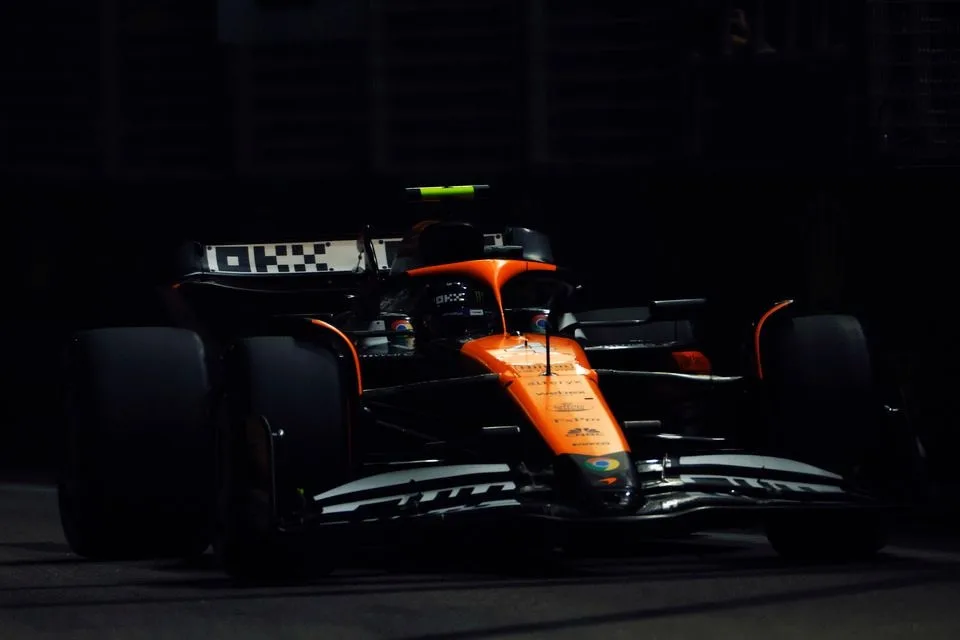UNBELIEVABLE DISCOUNTS AT AMAZON.COM ||
McLaren team boss Andrea Stella thinks it is a good thing that rival teams are complaining about its car – because this shows they are distracted from their own efforts.
The Woking-based team has found itself the centre of attention since the Azerbaijan Grand Prix over what has become known as its ‘mini-DRS’.
The team appeared to have designed its low-drag rear wing in such a way that the upper element cleverly flexed back to help open up the slot gap – delivering a drag reduction and therefore straightline speed boost.
While the rear wing fully complied with the FIA’s static load tests, its behaviour upset competitors who felt it was pushing the boundaries of the regulations too much.
Following discussions with the FIA, McLaren agreed to make modifications to reduce the flexibility which was seen to be present on its cars in the Belgian, Italian and Azerbaijan grands prix.
And while the tweak will mean McLaren losing whatever advantage it got from its design when that specific low-drag wing returns at the Las Vegas Grand Prix, Stella is far from disheartened about what has happened.
In fact, he says he actually takes heart from competitors paying so much attention to what his own squad is up to.
Asked for his thoughts on the matter, Stella said: “I find that so much attention on our rear wing is just good news, because it means that opponents are not focusing on themselves.
Andrea Stella, Team Principal, McLaren F1 Team
Photo by: Steven Tee / Motorsport Images
“Formula 1 is such a marginal game. It’s so complicated. I keep repeating to my team: ‘Focus on yourself’.
“So for me, when I see that there’s so much attention from other teams, it means that they will be doing work, they will be doing analysis, they will be talking to the FIA…
“They’re using this time and energy to chase something that I think is a red herring. So for me, as McLaren, that’s just good news.
“We try to stay focused on ourselves. We want to come with technical solutions that may be challenging but totally sound from a legality point of view. If others want to get destructive, keep doing that. Because for us, it’s just good news.”
FIA response
Although McLaren remains convinced that its wing design is fully legal, the team says that it agreed with the FIA to make changes because it did not want the controversy to blow up any more – and it also hoped this would prompt the governing body to also look at what other teams were up to.
“For us, making changes is pretty much transparent, so we may as well do it, as it won’t be a big consequence from a performance point of view,” said Stella.
“This also gave us the opportunity to [remind] the FIA that, you know, we also do some due diligence in terms of studying other people.
“We don’t want to spend so much energy and time with journalists and trying to create big stories. We just told the FIA what we think is happening.
“We trust, and we are confident, that they will talk to the other teams and make sure that they fix their own issues, which may be less visible, but definitely they do exist.”
Oscar Piastri, McLaren MCL38
Photo by: Lionel Ng / Motorsport Images
While Stella did not want to get drawn into what aspect of rival cars he felt the FIA should be looking at, he suggested that the issue revolved around manipulation of the rear wing slot gaps.
Pushed on what he was seeing in other teams, Stella said: “I will not be precise, because I would be disclosing information that I think fits within a confidentiality range.
“For some reasons, this slot gap seems to have become something that dominates F1. There’s many ways in which other cars are exploiting aerodynamic pressure on surfaces – actually, based on our analysis, some of them are just quite a lot more effective.
“But we do trust the FIA. They are very competent people from a technical point of view.
“To be honest, when we have conversations with them, not only do we see that they understand mechanisms, but they also understand what is going on with our competitors.
“They always seem to be pretty equipped in terms of understanding whether some of the tests are suitable – to limit some mechanisms or ways of aerodynamic pressure.
“I think we are in good hands from a policy point of view, with the FIA, and I think we should have all parties – teams, journalists, everyone – [give] a little bit more respect for the FIA and their technical department, because they do a very good job.
“It’s not a simple job. Sometimes we should praise what they do. And I don’t see this being done very much.”

